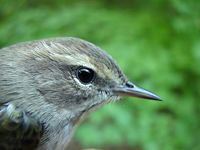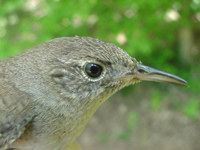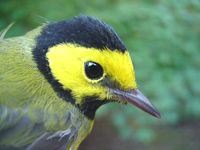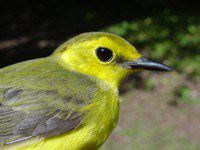 HOME: www.hiltonpond.org |
|
||
|
|
|||
|
|
|||
|
|
|||
|
|
|||
|
|
|||
 |
HILTON POND 1-7 October 2001 |
 HOME: www.hiltonpond.org |
|
||
|
|
|||
|
|
|||
|
|
|||
|
|
|||
|
|
|||
 |
HILTON POND 1-7 October 2001 |
|
When autumn days grow short and temperatures cool, many birds that spend all summer at Hilton Pond Center return to their "winter" homes in the Neotropics. And it's a good thing, since many of our summer breeders are primarily insect-eaters that would find slim pickings after the first frost hits. Perhaps the only reason these birds come north in spring is to take advantage of North America's abundant topography, where there's plenty of room to raise a family or two. If so, there's no reason to stay here in winter when eggs would freeze and hungry nestlings would die for lack of food. Considering all this, you might think it strange that we found an active bird nest colony at Hilton Pond Center the first week in October . . .
. . . until we explain that our discovery was actually a cluster of Bird's-nest Fungi. This little fungus is aptly named, for it does indeed look much like a structure built by birds, and the resemblance is greatly enhanced by a cluster of "eggs" that lies within. Several species of Bird's-nest Fungi occur in North America, but among the most common--and the one we found at Hilton Pond Center--is Striate Bird's-nest, Cyathus striatus, so-called because of vertical lines or striations inside the cup.
Bird's-nest Fungi are true saprophytes that live off dead matter such as sticks, bark, old wood, or other plant debris; our colony at Hilton Pond Center erupted on wood chips we had spread to stop erosion along a trail. When conditions are right--i.e., moist ground and warm temperatures from July through October--Striate Bird's-nest appears as a tiny brownish-tan button that elongates into a shaggy, vase-like structure about a half-inch tall (above right). As the vase develops, the "nest" opening is covered by a thin, white membrane (below left) that eventually ruptures to reveal the dark gray "eggs" within.
Although Bird's-nest Fungi occur naturally in open woodlands in much of the U.S., perhaps the best place to look for them is beneath the shrubs in your own front yard--right where you scattered that layer of wood mulch to keep down the weeds. A Bird's-nest Fungus may not be as showy as your spring azaleas, but it's at least as interesting to look at, and it plays a valuable role by decomposing organic matter and returning valuable nutrients to the soil. At Hilton Pond Center we're more than a little grateful for decomposers such as Bird's-nest Fungi, without which our trails would soon be knee-deep in unrotted twigs, leaves, and tree limbs. If you enjoy "This Week at Hilton Pond," please help Support Hilton Pond Center for Piedmont Natural History. It's painless, and YOU can make a difference! You may wish to consult our Index of all nature topics covered since February 2000. |
 Young birds lack the rusty brown cap typical of adults The following species were banded this week (1-7 October): Chestnut-sided Warbler--1  A brownish bird with dark barring on wing and tail--characteristic of most wrens |
WEEKLY BANDING TOTAL YEARLY BANDING TOTAL (2001) 70 species 1,155 individuals BANDING GRAND TOTAL  The hood of an adult male extends to form a bib; the female (below) has a greenish cap and no bib 
NOTABLE RECAPTURES WITH ORIGINAL BANDING DATES: Brown Thrasher (1) 10/10/95 |
|
Up to Top of Page Current Weather Conditions at Hilton Pond Center |
 "HUMMINGBIRD MORNINGS" "HUMMINGBIRD MORNINGS"In 2001, informative and entertaining hummingbird banding presentations were held at four Carolinas locations for more than 500 participants. For more info, and especially if your group would like to host "Hummingbird Mornings" in 2002, click on the hummingbird drawing at left. |
 post questions for The Piedmont Naturalist |
 Nature Study Network |
Hilton Pond Center |
|
|